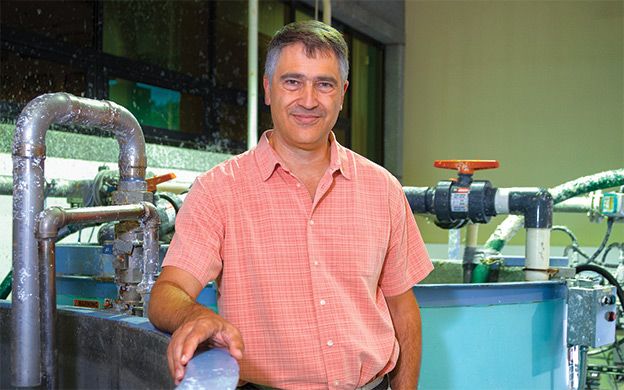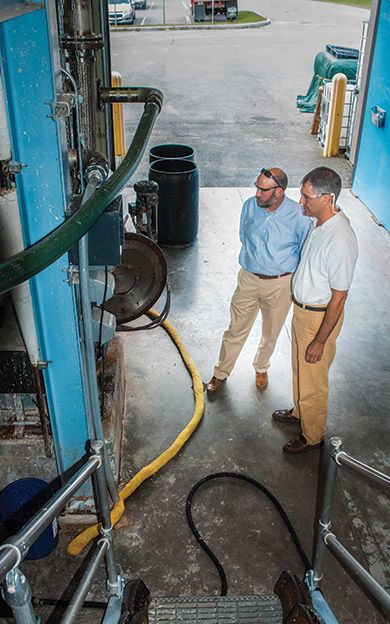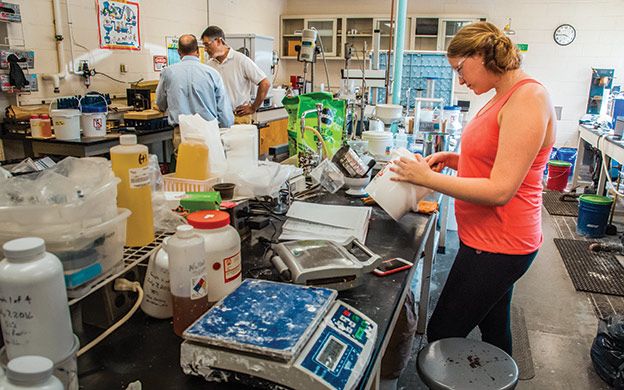UMaine, Twin Rivers Paper 'cross-pollinate' R&D
Twin Rivers Paper Co., a specialty paper company that announced in June it will invest $12 million to upgrade its Madawaska paper mill, is moving its research and development operations from Montreal to Orono.
The move will give Twin Rivers greater opportunities to tap into the University of Maine's network of innovators at its Process Development Center and comes at a time when the paper company is expanding its offerings of “customized solutions” for its customers.
“The growth in our company has been as a result of strategic market focus, carefully positioned capital expenditures and the development of new products,” says Dave Deger, vice president of strategy and marketing for Twin Rivers, which also operates a pulp and energy complex in Edmundston, New Brunswick, across the St. John River from Madawaska, and a lumber mill in Plaster Rock, New Brunswick, about 75 minutes from Madawaska. “In some cases this has been done to protect our core markets with new derivatives of existing products, but [it also involves] expanding capabilities to acquire business in adjacent markets.”
The $12 million investment in the Madawaska mill includes upgrades to its No. 8 machine that will maximize productivity and “focus on growth-oriented market segments,” the company said. Deger says the University of Maine's expertise in the forest products industry played a role in the company's decision to move its R&D operations to Orono.
“We have had a great relationship with the University of Maine, in particular the pulp and paper engineering group and its resources,” he says. “The network of people within the university and the partnerships created by our association will help in developing cutting-edge technology, but more importantly in working to commercialize those technologies.”
Maine has seen five paper mills close in the past five years. As one of only six paper mills remaining in the state, Twin Rivers' efforts to improve the competitiveness of its Madawaska facility is of no small consequence. The mill employs 500 workers and has an annual economic impact of $344 million in combined operations and average annual capital expenditures in Madawaska, with its payroll and benefits costs comprising roughly 21% of the total.
R&D for the forest products industry
In July, the Bangor Target Area Development Corp. received a $345,000 grant from the federal Economic Development Administration to create a wet laboratory at its Target Technology Center, at 20 Godfrey Drive in Orono, a short drive from the campus. The wet lab and related space will be used by both Twin Rivers and Cerahelix Corp., an early stage company making ceramic filters for various industries.
UMaine's role in helping the state diversify and strengthen its forest products industries highlights the value of its research capabilities.
“Overall, the work being done here at the University of Maine is emblematic of how a great university, together with effective and sustained regional collaboration can spur innovation, improve our country's global competitiveness, spur new and better jobs and drive economic resilience,” U.S. Deputy Assistant Secretary of Commerce for Economic Development Matt Erskine said at a July 29 press conference at the Orono campus.
In the entry way of the Process Development Center at UMaine's Forest Bioproducts Research Institute, there's a large poster showing every stage of the papermaking process. Each step of the papermaking process highlighted in the poster can be replicated inside the center, which has a pilot papermaking machine capable of manufacturing and testing virtually any kind of paper imaginable. The center operates as an open-access research facility where scientists, entrepreneurs and industry leaders develop new products and manufacturing processes.
“We work with 30 to 50 companies a year,” says Mike Bilodeau, who's been director of the center for 13 years. “We've had a very longstanding relationship with the paper companies in Maine.”
Twin Rivers is one of the center's clients and pays fees for the Process Development Center's services. The center is a self-funding operation with revenues derived from research and industrial partnerships that support operational costs and the salaries of eight full-time employees and five to 10 undergraduate interns. Much of the center's work, Bilodeau says, involves conducting scale-up, proof-of-concept pilot demonstrations of technologies and processes. For clients, research is key to the partnership.
“They find it very cost effective to rent time on our equipment,” Bilodeau says.
Fail fast, fail cheap
The center's mantra is “fail fast, fail cheap,” says Jake Ward, vice president for innovation and economic development at UMaine. Clients such as Twin Rivers can schedule blocks of time in which they use the center's pilot papermaking machine to quickly test prototypes and make improvements for either existing paper grades or new products they hope to bring to market.
With a new paper machine costing $700 million or more, and the need for efficient production on existing paper machines making it difficult to set aside time for even modest product testing, Bilodeau says companies welcome the opportunity to use the center's pilot equipment for testing concepts and products without a great outlay of capital or using valuable production time. It's an insight that precedes his stint as the Product Development Center's director: Prior to joining the university in 2003, Bilodeau worked for the S.D. Warren mill (now owned by Sappi North America) in research, development and corporate engineering.
“For somebody already making paper, we can tell them, 'Tweak this, or tweak that, and for a modest capital investment you can make this paper product,'” he says.
Bilodeau says a client might spend weeks or even months with the center's staff researchers developing formulas for new paper products they wish to test before actually scheduling trials on the pilot papermaking machine. “Typically, the trials run a week at a time,” he says, noting that they might test as many as eight different prototypes. “Then, from those trials, they might select the best candidate that we can scale up to do a mill trial.”
Ward adds: “It's not just a recipe, they've already done the taste test.”
“We have long been a proponent of the 'fail fast, fail cheap' model,” says Twin Rivers' Deger. “The use of screening criteria in R&D and pilot testing ensures the best and most efficient design prior to go to larger commercial production on our paper machines. Trial time on our paper machine is a significant investment and there is a high-dollar cost for taking trial concepts and design of experiment work to our paper machines. The [Process Development Center's] work gives our team the best opportunity to optimize the design prior to getting to our paper machines, reducing development costs and ensuring a compression in timelines to commercialization.”
Target Innovation Center upgrades
Moving Twin Rivers' R&D operations from Montreal to Maine puts it two hours closer to the Madawaska mill, which Deger says has the potential to reduce costs by having the company's “operating, technical, product development and sales and marketing teams working more cohesively in product and market development.”
The new wet laboratory in Orono will facilitate those efforts. But Twin Rivers also plans to offer its wet lab services to other companies in Maine and outside the state. “This offering should lead to additional job opportunities as well,” he says.
Evan Richert, a land use planning consultant who wears multiple hats as Orono's town planner and president of the Bangor Target Area Development Corp., says the Target Innovation Center is a critical link in the region's economic development efforts. The Target Center has a mix of startup and more-developed “market” companies as tenants, which collectively have 48 full-time employees.
The other tenant using the wet lab, Cerahelix, produces high-capacity water purification technology for the oil and gas and other industries. It outgrew lab space at the Target Center and inititated the conversation about creating a web lab that eventually benefited Twin Rivers as well.
“When Twin Rivers said they were looking for lab space, we knew the timing was perfect,” Ward says. “That's why having the Target Center and it being plugged into the region's economic development networks is so important. When the opportunities come up, there are people ready to make things happen.”
Richert says the total cost of developing two wet labs at the Target Center will be $690,000, with the EDA's $345,000 grant being matched with funds from the Bangor Target Area Development Corp. “The EDA's funding is essential, it's a linchpin piece of this project,” he says. “Initially, we were going to go ahead with a generic wet lab, but after talking to Twin Rivers, the size and scope of the lab grew accordingly.”
“We basically outgrew the space we were in,” says Susan MacKay, founder and CEO of Cerahelix. “The new space is an upgrade for us. It improves the quality of our laboratory facility and enables us to do the next level of research and design work we need to be doing to grow our revenues and sales.”
MacKay expects work on the new wet lab spaces will be completed late this year or in early 2017.
Since the Target Center also happens to be a short drive from UMaine's Product Development Center, Deger says it has the added benefit of providing Twin Rivers' R&D researchers there the “opportunity for cross-pollinating” with other innovators that are part of UMaine's network.
“It's just easier for people to meet, share experiences, get outside talent into the area, meet our customers face to face and work with the university network,” he says. “The network of people within the university and the partnerships created by our association will help in developing cutting-edge technology, but, more importantly, in working to commercialize those technologies. We aspire to have University of Maine students working as interns in the technical center and will work with the university to provide both short-term and longer-term employment for graduates in the pulp and paper program.”
Read more
Production ceases at Madison mill after nearly four decades
Federal team established to aid struggling forest product industry
Global demand spurs growth in new forest product sectors
Sappi approves $25M investment at Somerset Mill in Skowhegan
Federal team begins assessment of struggling forest products industry
Sappi North America launches paper inspired by shark skin
Report: Maine loggers contribute $882M to state economy
UMaine, USM receive $116K for forest product support
Sappi NA recognized for economic efforts in Maine
UMaine Business Challenge lands $30K sponsorship
Twin Rivers to acquire paper division of New York's Burrows Paper
















Comments